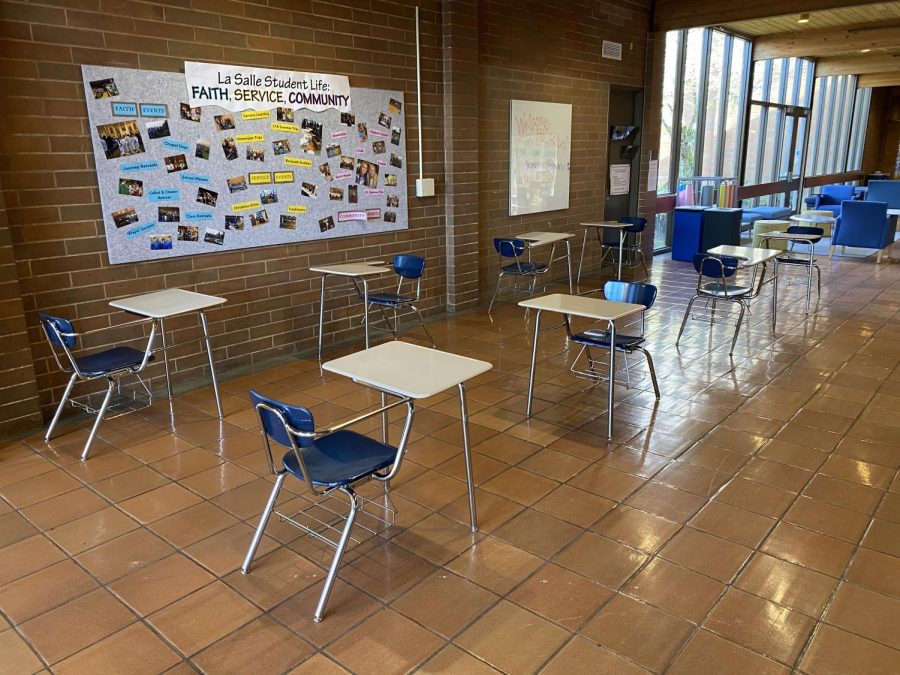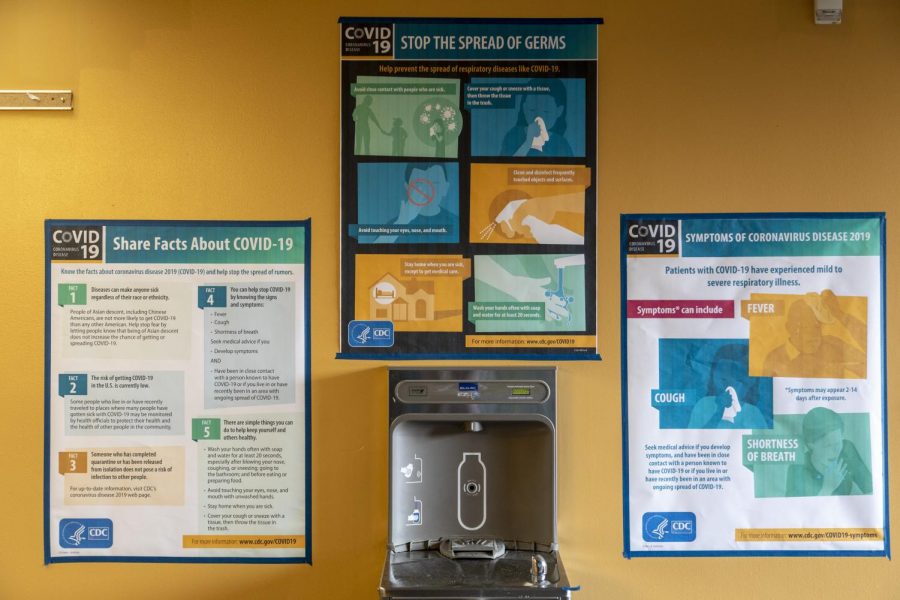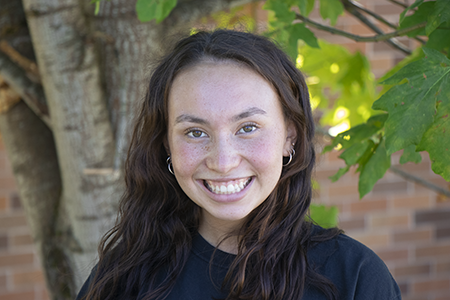La Salle Announces Plan to Shift to Hybrid Learning Model
Before the shift to distance learning in March of 2020, posters about COVID-19 prevention were displayed around the school.
January 13, 2021
After a digital conclusion to the 2019-20 academic year and almost a whole semester of distance learning this school year, Interim Principal Ms. Alanna O’Brien and President Mr. Andrew Kuffner announced on Jan. 7 La Salle’s plans to shift to a hybrid model of instruction for the second semester.
In a letter to families, school leadership shared the return to campus plan, emphasized a priority for adherence to safety protocols, and said that by Feb. 22, the school intends to have gradually shifted into full hybrid instruction, in which half of the students attend classes on campus while the other half learn from home.
The announcement came after Oregon Gov. Kate Brown rolled back the state’s previous mandate for school districts to reach certain metrics in COVID-19 case counts before returning to campus, leaving school districts to make reopening decisions for themselves and allowing schools to begin in-person instruction starting Jan. 1.
“I know that there’s a lot of concerns about case counts being higher in Oregon now than they were, even over the summer,” Ms. O’Brien said. “But it’s also tricky when you layer that upon where Oregon is with the rest of the country, and Oregon being significantly lower than a lot of the states where we have Lasallian schools that have been in full instruction and done so successfully… I do believe that we’re in a place where we can at least try and do some things safely.”
Ms. O’Brien said that the administrative team aims to be “flexible and compassionate,” and to work in the “best interests” of the students, as different people have had differing experiences, struggles, and successes with the online learning format.
“We believe our students need something different than what we currently have,” she said. “The number one reason [for returning to campus] is we want to support the kids in front of us. We do recognize that there is an investment made by families that we want to honor, and we believe that we can do things safely, and we have been collaborating with other institutions who have done so.”
In the hybrid model, students will be split up into two cohorts, with one cohort attending in-person classes on Mondays and Tuesdays and the other on Thursdays and Fridays. Cohorts will be determined by ZIP codes “to ensure students in the same household remain together and to make transportation as easy as possible,” La Salle administration said. The announcement said that families will receive cohort assignments by Wednesday, Jan. 20, along with the option to submit a formal request for those who need a cohort change.
In the return to campus plan, the administration outlined four core commitments: to transformative learning and growth; to community and connection; to diversity, equity, inclusion, and belonging; and to health, safety, and well being.
The letter said that the hybrid model will “allow us to adhere to safety protocols” for the prevention of the spread of COVID-19, and that while this format is “different than traditional high school instruction,” with strict policies around precautions like distancing and face coverings, “we believe students will benefit from this model.”
Students have varying levels of excitement and concern about the school’s announcement of the hybrid plan.
Senior Michael Drenner said that as long as proper safety regulations are adhered to, he would like to go back to in-person learning.
“I really want to see my friends,” he said. “It’s just a better environment.”
Though Drenner is not a fan of distance learning, he said that he would only participate in the hybrid model if it feels “safe enough.”
“Most of us aren’t going to die from COVID, but then we bring it back home to our families, and that’s what’s complicated about it,” he said. “If [the hybrid model] doesn’t follow every single rule that we have to follow for COVID, then I’m not going to do it.”
Junior Molly Schmidt also expressed concern about potentially exposing herself to COVID-19 and transmitting it to loved ones.
“It would be really good to go back and see people,” Schmidt said. “But at the same time, I feel like it’s a lot less stress, at this point, to stay home.”
Schmidt said that with the ease with which the virus spreads, and because her dad is immunocompromised, she worries about putting others — like her family — at higher risk of COVID-19 contraction.
“If one person gets COVID and goes to school, it can spread really fast,” she said.
In addition, Schmidt worries that precautions to prevent the spread of the virus won’t always be well executed, as it can be difficult to “manage everything,” such as keeping masks on and maintaining a six-foot distance, she said.
“When we went back for welcome day and stuff, a lot of people weren’t respecting those distances and mandates,” Schmidt said. “I understand that [they] will be enforced in school, but I feel like there’s so much that’s still up in the air.”
A number of health and safety protocols are laid out in the return to campus plan, including policies and expectations around face coverings, physical distancing, and daily wellness checks, with students and staff answering symptom-related questions using the SchoolPass app before arriving on campus each day.
Various areas will be spaced and marked for lunchtime seating, including in the cafeteria, main hallway, courtyards, and outdoor spaces. Masks can be removed when eating, with a minimum of six feet distance between individuals.

Students and staff are also expected to maintain physical distancing in hallways, which will be designated in a one-directional manner. The passing period between classes is expanded to 10 minutes in order to reduce the flow of foot traffic in the hallways and minimize the density of people within the space at a given time.
Spanish teacher Ms. Amy Gantt said that while she would ideally like to “see students as quickly as possible,” she does feel “uneasy” and “nervous” about returning to on-campus instruction due to the risk of the spread of COVID-19.
“I’m okay with getting back, but I want it to be in the safest way possible,” Ms. Gantt said. “I’m not in any rush to get back, because I would rather people be vaccinated.”
Though her preference would be to return once distribution of the newly-approved coronavirus vaccines is more widespread throughout the school community, Ms. Gantt also acknowledged that other factors affect the planning for reopening.
“I also know that the people making the decisions have a lot of things that they have to weigh out,” she said. “There’s a lot of factors that they have to consider, and I’m not in the know of all that. But, I worry about the health and the safety of the students, and of fellow colleagues.”
Ms. Gantt said that with the extensive amount of protocols to manage while on campus — keeping windows open for ventilation, remaining diligent about physical distancing and face coverings, sanitizing hands and desks after each class period, to name a few — she worries that the hybrid format will be “overwhelming,” especially in addition to tending to students’ needs both in the classroom and through Zoom.
She also expressed concern about how far the safety rules will be pushed, how stringently they will be enforced, and how effectively they will be followed.
“By human nature, we tend to try to break rules a little bit,” Ms. Gantt said. “We all tend to take things onto our own and decide whether the rules apply to us or not, and we can’t do that. That can’t happen. It’s not about each individual, it’s about everybody taking precaution for everybody else, including themselves. It truly has to be a community effort in order for this to go smoothly.”
***
Stay tuned to The Falconer in coming weeks for further coverage of La Salle’s return to campus plans, and the community’s reactions around the announcement of the hybrid model.






Liane Hansen • Jan 18, 2021 at 7:06 pm
What a well written article! Well organized and concise while openly addressing major concerns that I have heard from many parents and students. Why not continue a successful distance learning program until the majority of the population is vaccinated? We increase the likelihood of having a ‘normal’ Fall 2021 by following protocol and continuing to shelter in place as much as possible. Our generally well-nourished and healthy students may be more likely to be asymptomatic carriers of COVID-19, and then unknowingly expose loved ones, essential workers such as grocery store workers, or anyone less likely to be able to fight the virus, including not-yet-vaccinated teachers and staff, ultimately increasing the stress on our valiant health care workers. Bringing people together indoors after the two worst months of the pandemic, while at least one ‘more contagious’ U.K. mutation is now here in the U.S., seems irresponsible. Furthermore, introducing a complicated, untested ‘hybrid learning’ model is yet an additional stress to teachers and students, and isn’t expected to be in full-swing until Feb. 22, if all goes well, which is only a few weeks before spring break and Easter, a holiday during which many Christian families are likely to “stretch the rules” on indoor gatherings, and likely cause yet another spike to bring back to school.
I don’t understand why we are not doing our duty to serve others by doing as much as possible to stop the spread of the virus, responsibly await the vaccine, and protect those with ‘less fortunate’ immune systems than our healthy teenagers.
I wish I was as good a writer as you!